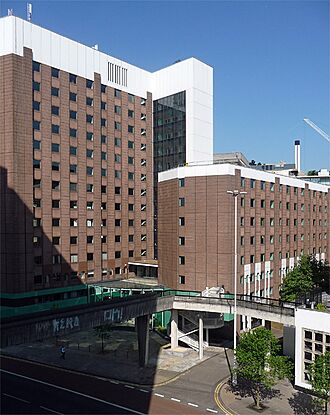Greyfriars, Bristol facts for kids
Quick facts for kids Greyfriars, Bristol |
|
|---|---|
 |
|
| General information | |
| Architectural style | monastic |
| Town or city | Bristol |
| Country | England |
| Coordinates | 51°27′29″N 2°35′44″W / 51.458098°N 2.595649°W |
| Construction started | 13th century |
| Demolished | 16th century |
Greyfriars was once a Franciscan friary in Bristol, England. A friary is like a monastery, but friars often travel and preach instead of staying in one place. The name Greyfriars came from the grey robes the friars wore.
The friary was started before 1234. It was first built inside the town walls. Later, in 1250, it moved to an area called Lewin's Mead. The new site had large gardens and was surrounded by a stone wall.
In the 1500s, during a time called the Dissolution of the Monasteries, the friary was closed down. In 1541, the land was given to the Bristol town council. They wanted to use the stone to fix the town walls and the harbour. Over the years, the site has been used for many different things. Today, it has an office building and part of Bristol Dental School.
The Story of Greyfriars
The Greyfriars friary was built sometime before 1234. We know this because King Henry III gave wood to the friars for fuel that year. He also gave them oak wood and fresh fish from Bristol. The friars wore long grey coats with hoods. This is why they were called "grey friars."
The friary first stood inside Bristol's town walls. But in 1250, it moved to Lewin's Mead. This move happened after the River Frome was changed to create St Augustine's Reach. A wet, marshy area near the river was drained. Clay and rock from the river digging were used to fill it in.
Building the Friary
The first church on the site was about 50 meters (164 feet) long and 9 meters (30 feet) wide. Later, more parts were added. These included cloisters, which are covered walkways, a bell tower, and a chapter house. A chapter house is where the friars met for important discussions.
The buildings were made from local red sandstone. The Bristol City Museum has some beautiful stained glass from the chapter house. This glass was likely found after the friary closed.
In the 1400s, a writer named William Worcester described the friary's area. It was roughly bordered by today's Upper Maudlin Street, Lower Maudlin Street, Lewin's Mead, and Johnny Ball Lane. The friars had large gardens where they grew plants. There were also two lime kilns, which are ovens for making lime. Stone walls surrounded the entire area.
The Friary Closes Down
In 1538, during the Dissolution of the Monasteries, a report was made by Richard Yngworth. He said the leader of the friary was "stiff," meaning difficult. Six friars were still living there when they gave up the property to Ingworth. After this, the friary was officially closed.
The land was rented to a man named Jeremy Green for a small yearly fee. Then, in 1541, Henry VIII gave the friary, along with other closed religious houses, to the Mayor and people of Bristol. They paid £1,000 and a yearly rent of £20. The Mayor had asked the king for the friary. He said it was built by Bristol citizens and they wanted to use its stone to fix the town's walls and harbour.
What Happened Next
After the friary closed, the site was rebuilt many times over the centuries. A Moravian church and even a chocolate factory were once located there.
Today, an office building called Greyfriars stands on the site. Parts of Bristol Dental School are also there.
In 1989, during construction work, parts of the old abbot's house were found. A small oval window from the old building was even put into the new one. Digs by archaeologists have also found graves with human remains. These graves date from the 1200s to the 1400s. They also found an old water pipe, similar to one found at Saint Augustine's Abbey in Bristol.

